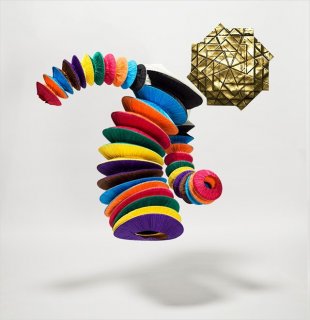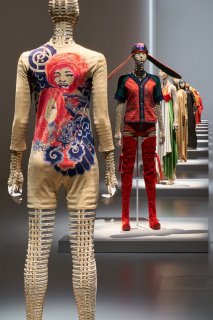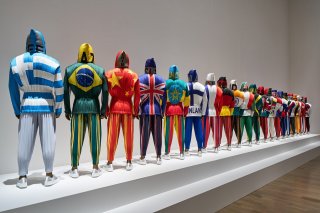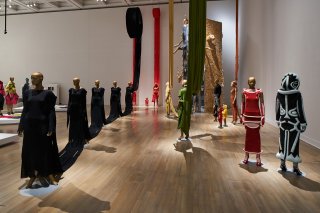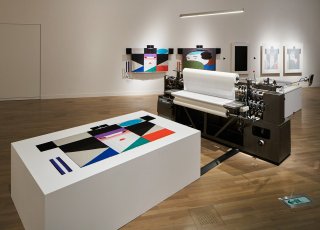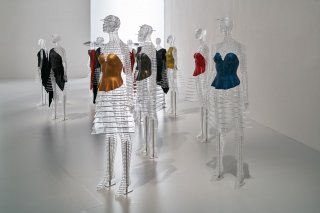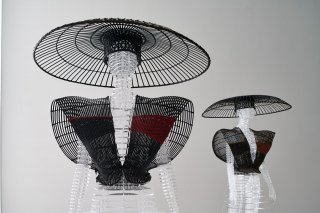-
Announcing... The WINNERS of the 2025 theFashionSpot Awards:
Designer of the Year
Ready-to-Wear Collection of the Year
Haute Couture Collection of the Year
Model of the Year
Photographer of the Year
Stylist of the Year
Magazine Cover of the Year
Ad Campaign of the Year
Congratulations to ALL of our worthy winners! Thank you to our tFS forum members who voted and participated.
You are using an out of date browser. It may not display this or other websites correctly.
You should upgrade or use an alternative browser.
You should upgrade or use an alternative browser.
gius
Active Member
- Joined
- Jan 8, 2006
- Messages
- 10,853
- Reaction score
- 12
also check this thread
Issey Miyake A-POC Collections
to find more articles, just click the drop down arrow next to Search
to go to Advanced Search
you can choose to search through thread titles , to find topics more easily
Issey Miyake A-POC Collections
to find more articles, just click the drop down arrow next to Search
to go to Advanced Search
you can choose to search through thread titles , to find topics more easily

softgrey
flaunt the imperfection
- Joined
- Jan 28, 2004
- Messages
- 52,984
- Reaction score
- 415
the Wind-
Issey Miyake + Dyson (yes- the vacuum cleaner!!!)
http://www.isseymiyake.dyson.com/
this design collaboration is launched in ISSEY MIYAKE stores in Paris and Tokyo Spring 2008...
check the link for pics...
if anyone can capture them and post them here that would be great!
thanks...

Issey Miyake + Dyson (yes- the vacuum cleaner!!!)
http://www.isseymiyake.dyson.com/
this design collaboration is launched in ISSEY MIYAKE stores in Paris and Tokyo Spring 2008...
check the link for pics...
if anyone can capture them and post them here that would be great!
thanks...

Charllotte
Active Member
- Joined
- Apr 11, 2006
- Messages
- 7,207
- Reaction score
- 0
Charllotte
Active Member
- Joined
- Apr 11, 2006
- Messages
- 7,207
- Reaction score
- 0
gius
Active Member
- Joined
- Jan 8, 2006
- Messages
- 10,853
- Reaction score
- 12
^ really beautiful!
many thanks, charlotte
i see he is using whole sheets of paper and texturizing them
the creamy tan one looks like it even has a nonwoven lining..interfacing on the inside..it looks soft
do you know if they are part of any seasonal collection?
many thanks, charlotte
i see he is using whole sheets of paper and texturizing them
the creamy tan one looks like it even has a nonwoven lining..interfacing on the inside..it looks soft
do you know if they are part of any seasonal collection?
bobble-bee
Member
- Joined
- Dec 16, 2006
- Messages
- 173
- Reaction score
- 0
A mini bio...
Issey Miyake
By Sara Templeton

And why not? Many of the designs from Miyake et al are stunningly beautiful, but not the kind of thing you'd wear to the cricket, or even to dinner in some cases.
Issey Miyake thinks differently from the more orthodox designer. Hailing from Japan, most would expect him to create 'art pieces' with an oriental flavour.
While he will do this - and still does - he also creates pieces that are far more westernised than most would expect.
Born in Hiroshima, Japan, in 1938, Issey Miyake was seven years old when the USA dropped an atomic bomb on his country.
Sadly, his mother was badly burned by the bombing of Hiroshima and died four years later. But, in an ironic twist of fate, the American occupation of Japan that occurred after the attack gave a young Issey a first-hand look at Western culture.
Miyake had always wanted to be a fashion designer, and in 1959 he enrolled in a graphic arts course at Tokyo's famous Tama Art University. Five years later - in early 1965 - he moved to Paris to fulfil his dream and started looking for work in the Big Smoke.
Right out of the blocks, Miyake's talent was evident and he scored a gig with Guy Laroche in only his second year in France, which lasted from 1966, to 1968. In the year that he ditched Laroche, he was snapped up by none other than the Givenchy house of design.
Then in 1969 he moved to New York City to work for Geoffrey Beene and two years later, after earning a good deal of capital, he set up his first creative studio - the Miyake Design Studio, or MDS, in Tokyo. This wasn't so much a place of design and production, but a more a laboratory of sorts, where Miyake started experimenting with various blends of fabric and synthetic textiles.

Miyake's first fashion show in Paris was a hit (1973) and by '79, he had set up an arm of his design house in France.
During the '70s Miyake's work was largely conceptual - he pioneered a vast array of techniques, many incorporating age-old Japanese traditions - but it was the during 1980s that Miyake stirred the soul of the masses.
Creating more affordable ensembles, Issey Miyake's trademark of the 1980s was practicality and usefulness in fab.
Making use of natural fibres and other fabrics, painstakingly researched at the Miyake Design Studio in Tokyo, his designs became hugely successful, not just in high cultural circles, either.
In the '90s Issey Miyake is largely accepted for kicking off the pleat, which today comes and goes with fashion trends year-in and year-out. His development of the pleating theory revolved around first sewing garments, then finishing them, and finally the pleating.
From here on in, Miyake's designs would influence not just the world of fashion, but even sport. For instance in 1992, Miyake designed the pleated jackets for the Lithuanian team at the Barcelona Olympics.
Today Issey Miyake's designs can be purchased all around the world, particularly here in Australia. He has quite a following locally, and right around the world, and doesn't look like slowing any time soon.
source
Issey Miyake
By Sara Templeton
The man himself: Issey Miyake
Issey Miyake, one of the Nihon's most respected and well-known designers, refers to his designs not as clothing, or ready-to-wear ensembles, but rather art pieces.And why not? Many of the designs from Miyake et al are stunningly beautiful, but not the kind of thing you'd wear to the cricket, or even to dinner in some cases.
Issey Miyake thinks differently from the more orthodox designer. Hailing from Japan, most would expect him to create 'art pieces' with an oriental flavour.
While he will do this - and still does - he also creates pieces that are far more westernised than most would expect.
Born in Hiroshima, Japan, in 1938, Issey Miyake was seven years old when the USA dropped an atomic bomb on his country.
Sadly, his mother was badly burned by the bombing of Hiroshima and died four years later. But, in an ironic twist of fate, the American occupation of Japan that occurred after the attack gave a young Issey a first-hand look at Western culture.
Miyake had always wanted to be a fashion designer, and in 1959 he enrolled in a graphic arts course at Tokyo's famous Tama Art University. Five years later - in early 1965 - he moved to Paris to fulfil his dream and started looking for work in the Big Smoke.
Right out of the blocks, Miyake's talent was evident and he scored a gig with Guy Laroche in only his second year in France, which lasted from 1966, to 1968. In the year that he ditched Laroche, he was snapped up by none other than the Givenchy house of design.
Then in 1969 he moved to New York City to work for Geoffrey Beene and two years later, after earning a good deal of capital, he set up his first creative studio - the Miyake Design Studio, or MDS, in Tokyo. This wasn't so much a place of design and production, but a more a laboratory of sorts, where Miyake started experimenting with various blends of fabric and synthetic textiles.
Issey: Mens fashion that doesn't suck
Soon after this in 1971, Miyake International Incorporated was set up and the Japanese designer launched his first collection. It was exhibited in both New York, where he was residing, and also in Tokyo.Miyake's first fashion show in Paris was a hit (1973) and by '79, he had set up an arm of his design house in France.
During the '70s Miyake's work was largely conceptual - he pioneered a vast array of techniques, many incorporating age-old Japanese traditions - but it was the during 1980s that Miyake stirred the soul of the masses.
Creating more affordable ensembles, Issey Miyake's trademark of the 1980s was practicality and usefulness in fab.
Making use of natural fibres and other fabrics, painstakingly researched at the Miyake Design Studio in Tokyo, his designs became hugely successful, not just in high cultural circles, either.
In the '90s Issey Miyake is largely accepted for kicking off the pleat, which today comes and goes with fashion trends year-in and year-out. His development of the pleating theory revolved around first sewing garments, then finishing them, and finally the pleating.
From here on in, Miyake's designs would influence not just the world of fashion, but even sport. For instance in 1992, Miyake designed the pleated jackets for the Lithuanian team at the Barcelona Olympics.
Today Issey Miyake's designs can be purchased all around the world, particularly here in Australia. He has quite a following locally, and right around the world, and doesn't look like slowing any time soon.
source
bobble-bee
Member
- Joined
- Dec 16, 2006
- Messages
- 173
- Reaction score
- 0
gius
Active Member
- Joined
- Jan 8, 2006
- Messages
- 10,853
- Reaction score
- 12
article|
Architect Arata Isozaki began an essay in Issey Miyake's East Meets West with the question, "What are clothes?" The question, perhaps too fundamental and unnecessary for most designers, is the matrix of Issey Miyake's clothing. Possibly more than any other designer of the 20th or 21st centuries, Miyake inquired into the nature of apparel, investigating adornment and dress functions from all parts of the world and from all uses and in all forms, to speculate about clothing. Aroused to question fashion's viability in the social revolution he observed in Paris in 1968, Miyake sought a clothing of particular lifestyle utility, of renewed coalition with textile integrity, and of wholly reconsidered form. In exploring ideas emanating from the technology of cloth, Miyake created great geometric shaping and the most effortless play of drapery on the bias to accommodate body motion since his paragon Madeleine Vionnet.
Miyake's highly successful Windcoats wrap the wearer in an abundance of cloth but also generate marvelously transformative shapes when compressed or billowing and extended. In these efforts, Miyake created garments redolent of human history but largely unprecedented in the history of dress. As a visionary, he often seemed to abandon commercial ideas of dress for more extravagantly new and ideal experiments, such as a 1976 knit square with sleeves, which became a coat with matching bikini; or fall/winter 1989-90 pleated collection which was a radical cubist vision of the human body and of its movement. Miyake has also worked with traditional kimonos, and has even experimented with paper and other materials to find the right medium for apparel. Despite unusual and some thoroughly utopian ideals, Miyake appeals to a clientéle of forward thinkers and designers who wear his clothing with the same zeal and energy from which they were created.
Miyake gives his work interpretative issues and contexts that contribute to their meaning, acknowledging the garments as prolific signs. His two earliest books East Meets West (Tokyo, 1978) and Bodyworks (Tokyo, 1983), were both accompanied by museum exhibitions of his many creations. Miyake can be anthropologically basic; again and again, he returns to tattooing as a basic body adornment, rendered in clothing and tights and bodysuits. He relishes the juxtaposition between the most rustic and basic and the most advanced, almost to prove human history a circle rather a linear progression. No other designer—with the possible exception of the more laconic Geoffrey Beene, for whom Miyake worked briefly and with whom he maintains a mutual admiration—interprets his work as deliberately and thoughtfully as Miyake.
Such allusiveness and context would have little value were it not for the abiding principles of Miyake's work. He relies upon the body as unerringly as a dancer might. He demands a freedom of motion that reveals its genesis in 1968. If Miyake's concept of the body is the root of all of his thinking, it is a highly conceptual, reasoned body. His books have customarily shown friends and clients—young and old— wearing his clothing. They come from East and West; they do not possess a perfect anatomy or the streamlined physique of body sculptures, but they are in some way ideals to Miyake.
Miyake's works have placed him in the worlds of both clothing designer and artist. His designs explore space and natural forms but are grounded in the understanding that they are to be worn. They exist in one form, only to be transformed when a body gives the piece a third dimension. This transforming power is evident in the endless variations of his pleats collection, which first appeared in his 1989 and was expanded into the Pleats Please line in 1993. Garments were constructed first and then pleated, a reversal of the standard process. Huge garments made of lightweight polyester were fed into a pleating machine and the resulting clothing was easy to wash, quick to dry, and wrinkle-resistant. This practicality reflected Miyake's dedication to the universality of his designs and proved to be a great commercial success. He opened the first Pleats Please store in SoHo in 1998, and the line is one of his most widely recognized.
Miyake's continual questioning and exploration of his own work led to another revolutionary concept in clothing design—mass-produced clothes designed to be individualized by each wearer. In 1999 he introduced the A-POC line, an abbreviation for A Piece of Cloth. In this line, the wearer takes scissors to a section of a continuous knitted tube with cutting guides to fashion her own garment, varying hem, sleeve lengths, and the neckline. The first store dedicated to the A-POC line opened in Tokyo in 1999. The A-POC line is but one example of how Miyake's designs originate with the fabric. His fascination with textiles continues to be the springboard for his work; whether the textiles are natural or synthetic, handwoven or high tech, Miyake transforms fabric into clothing that brings its wearer the joy of beauty and movement.
—Richard Martin;
updated by Janette Goff Dixon
same source|
Architect Arata Isozaki began an essay in Issey Miyake's East Meets West with the question, "What are clothes?" The question, perhaps too fundamental and unnecessary for most designers, is the matrix of Issey Miyake's clothing. Possibly more than any other designer of the 20th or 21st centuries, Miyake inquired into the nature of apparel, investigating adornment and dress functions from all parts of the world and from all uses and in all forms, to speculate about clothing. Aroused to question fashion's viability in the social revolution he observed in Paris in 1968, Miyake sought a clothing of particular lifestyle utility, of renewed coalition with textile integrity, and of wholly reconsidered form. In exploring ideas emanating from the technology of cloth, Miyake created great geometric shaping and the most effortless play of drapery on the bias to accommodate body motion since his paragon Madeleine Vionnet.
Miyake's highly successful Windcoats wrap the wearer in an abundance of cloth but also generate marvelously transformative shapes when compressed or billowing and extended. In these efforts, Miyake created garments redolent of human history but largely unprecedented in the history of dress. As a visionary, he often seemed to abandon commercial ideas of dress for more extravagantly new and ideal experiments, such as a 1976 knit square with sleeves, which became a coat with matching bikini; or fall/winter 1989-90 pleated collection which was a radical cubist vision of the human body and of its movement. Miyake has also worked with traditional kimonos, and has even experimented with paper and other materials to find the right medium for apparel. Despite unusual and some thoroughly utopian ideals, Miyake appeals to a clientéle of forward thinkers and designers who wear his clothing with the same zeal and energy from which they were created.
Miyake gives his work interpretative issues and contexts that contribute to their meaning, acknowledging the garments as prolific signs. His two earliest books East Meets West (Tokyo, 1978) and Bodyworks (Tokyo, 1983), were both accompanied by museum exhibitions of his many creations. Miyake can be anthropologically basic; again and again, he returns to tattooing as a basic body adornment, rendered in clothing and tights and bodysuits. He relishes the juxtaposition between the most rustic and basic and the most advanced, almost to prove human history a circle rather a linear progression. No other designer—with the possible exception of the more laconic Geoffrey Beene, for whom Miyake worked briefly and with whom he maintains a mutual admiration—interprets his work as deliberately and thoughtfully as Miyake.
Such allusiveness and context would have little value were it not for the abiding principles of Miyake's work. He relies upon the body as unerringly as a dancer might. He demands a freedom of motion that reveals its genesis in 1968. If Miyake's concept of the body is the root of all of his thinking, it is a highly conceptual, reasoned body. His books have customarily shown friends and clients—young and old— wearing his clothing. They come from East and West; they do not possess a perfect anatomy or the streamlined physique of body sculptures, but they are in some way ideals to Miyake.
Miyake's works have placed him in the worlds of both clothing designer and artist. His designs explore space and natural forms but are grounded in the understanding that they are to be worn. They exist in one form, only to be transformed when a body gives the piece a third dimension. This transforming power is evident in the endless variations of his pleats collection, which first appeared in his 1989 and was expanded into the Pleats Please line in 1993. Garments were constructed first and then pleated, a reversal of the standard process. Huge garments made of lightweight polyester were fed into a pleating machine and the resulting clothing was easy to wash, quick to dry, and wrinkle-resistant. This practicality reflected Miyake's dedication to the universality of his designs and proved to be a great commercial success. He opened the first Pleats Please store in SoHo in 1998, and the line is one of his most widely recognized.
Miyake's continual questioning and exploration of his own work led to another revolutionary concept in clothing design—mass-produced clothes designed to be individualized by each wearer. In 1999 he introduced the A-POC line, an abbreviation for A Piece of Cloth. In this line, the wearer takes scissors to a section of a continuous knitted tube with cutting guides to fashion her own garment, varying hem, sleeve lengths, and the neckline. The first store dedicated to the A-POC line opened in Tokyo in 1999. The A-POC line is but one example of how Miyake's designs originate with the fabric. His fascination with textiles continues to be the springboard for his work; whether the textiles are natural or synthetic, handwoven or high tech, Miyake transforms fabric into clothing that brings its wearer the joy of beauty and movement.
—Richard Martin;
updated by Janette Goff Dixon
same source|
gius
Active Member
- Joined
- Jan 8, 2006
- Messages
- 10,853
- Reaction score
- 12
chalk_love
Member
- Joined
- Apr 25, 2006
- Messages
- 170
- Reaction score
- 0

Seashell Coat, Coat, 1985
Issey Miyake (Japanese, b. 1938), Designer; Miyake Design Studio (Japanese), Design House
Japanese
cotton, nylon, linen; Length at CB: 23 1/2 in. (59.7 cm)
Gift of Muriel Kallis Newman, 2003 (2003.79.16)
via metmuseum
chalk_love
Member
- Joined
- Apr 25, 2006
- Messages
- 170
- Reaction score
- 0

Staircase Pleats, Dress, Evening, fall/winter 1994–1995
Issey Miyake (Japanese, b. 1938), Designer; Miyake Design Studio (Japanese), Design House
Japanese; Country of Origin Japan
synthetic; Length at CB: 65 in. (165.1 cm)
Gift of Muriel Kallis Newman, 2005 (2005.130.11)
via metmuseum
yvesmanoel
Member
- Joined
- Feb 11, 2010
- Messages
- 61
- Reaction score
- 0
couldn't anyone find or scan some pictures from the irving penn book?
softgrey
flaunt the imperfection
- Joined
- Jan 28, 2004
- Messages
- 52,984
- Reaction score
- 415
tokyo show...wish i could go...
Universal Fashion: Celebrating 45 Years of Issey Miyake
A major exhibition dedicated to the work and influence of the iconic Japanese designer is currently on show at The National Art Centre in Tokyo. AnOther pays a visit...
— May 13, 2016 —
TextNatalie Rigg
Issey Miyake, Flying Saucer, Spring/Summer 1994
Issey Miyake does not consider himself to be a fashion designer. Instead, informed and influenced by a multitude of disciplines, including architecture, the cross-pollination of cultures, modern art and environmental issues, he attests that his creative output is devoted to “making things, making a product that people enjoy and can wear freely.” It’s a relatively simple mantra for a man whose technically ingenious, experimental and soulful oeuvre – spanning 45 years – consistently breaks new ground.
Rather than subscribing to the often fickle and fleeting nature of seasonal trends, Miyake’s clothing habitually explores the relationship between a piece of cloth and the body, and the space that’s created as a result, utilising both traditional and avant-garde methods of craftsmanship in the process. Perhaps most importantly, his garments often raise questions about pressing critical issues – from ethical awareness to hedonism and racial diversity. Take the Spring/Summer 1971 ‘Tattoo’ flesh-tone jumpsuit [image displayed below], texturized with a large printed motif, which Miyake designed after establishing his eponymous label in Tokyo [Miyake Design Studio, or MDS] in 1970 – a physical expression of freedom that placed importance on the wearer, rather than the clothing itself by presenting a liberating ‘second skin’.
Now, Miyake enthusiasts are able to both celebrate and reconnect with his sartorial opus in the most extensive and comprehensive showcase of his designs to date in MIYAKE ISSEY EXHIBITION: The Work of Miyake Issey. Housed at the spectacular, Kisho Kurokawa-designed National Art Centre Tokyo, the exhibit (ten years in the making) is thematically divided into three parts, which mark different chapters of Miyake’s illustrious career from 1970 until the present day. Having been fortunate enough to visit the exhilarating show, AnOther unravels its prevailing themes.
The Extraordinary Everyday
“Mr Miyake works in the Japanese tradition of mono–zukuri [making things] while creating clothing from out of his own inspiration,” explains Dr. Tamotsu Aoki, Director General of The National Art Centre Tokyo. “Whenever I come across his work, I have surprise and good feeling. Why? Because at the base of his work is the philosophy of ‘everyday life’.” Indeed, this drive to offer wearable solutions to modern life – free-form clothing that places emphasis on physicality, constructed from very few seams – forms an evolving narrative throughout the exhibit, and remains at the heart of Miyake’s humanist design code. As he recalls of his thinking after witnessing the violent May Revolution protests in Paris during the late 1960s, “I was determined, I wanted to make clothes not for a limited group of rich people, but to make things like jeans and T-shirts, clothes that everybody knows and can easily wash and wear.”
This motivation is best exemplified in his revolutionary creation of PLEATS PLEASE ISSEY MIYAKE. Unveiled in 1993, the line, crafted entirely from thermally treated pleated polyester cloth, negates the use of threads, scissors or needles and is cut by a pioneering ‘heat machine’ – one of which graces the largest room of the exhibit, offering live demonstrations by Miyake-clad artisans, to the delight of visitors. “Pleating is one of humanity’s most ancient methods of making clothing that adapts to the body, and Miyake achieved a modern metamorphosis of pleats by making them both aesthetically valuable as well as being comfortable and practical (not to mention easy to care for),” says Yayoi Motohasi, curator of Toyko's National Art Centre. This signature use of pleating and the abstraction of simple silhouettes has become a pivotal expression in Miyake's design vernacular, and in turn, our own.
Design As Discovery
Experimentation is a vital tenet of Miyake’s aesthetic – achieved through a stimulating fusion of ancient techniques and pioneering technology. In the Spring/Summer 1981 creation 'Rattan Body', for example, Miyake called upon Japanese artisan Shochikudo Kosuge to develop an air-soft, yet surprisingly hardwearing fabrication, meticulously crafted from rattan and bamboo; the process of which is captured on film and shown at the end of the exhibition. Not only did 'Rattan Body' present a harmonious dialogue between Eastern artisan tradition and contemporary Western fashion, but it was also the first ever garment to land the cover of the contemporary art publication, Artforum.
Similarly progressive is a standout installation of looks from Miyake’s A-POC (A Piece Of Cloth) methodology, in which colossal rolls of woven fabric are hung (as though unravelling) from the ceiling to the floor of the exhibition space to demonstrate the digital fashioning of a fully-finished garment from a single, continuous knitted tube via computer programming. “It’s an operation that fundamentally inverted conventional ways of thinking about the manufacture of clothing, and has continued to develop further possibilities,” notes Motohashi. In addition to being a technical feat, this process virtually eliminates the wastage of fabric and aptly demonstrates Miyake’s own concerns with eco-awareness and sustainability.
Collaborative Harmony
Creative alliances with various artists have proved invaluable to Miyake, resulting in some of the most exciting works of his career. The bold Autumn/Winter 1976 'Paradise' shirt, which sets the exhibition off to a vibrant start, features specially designed artwork by the famed Tadanori Yokoo. Meanwhile the aforementioned pleating machine, which plays a starring role in the show, brings modern poster art by late graphic designer Ikko Tanaka to life in the form of kimono-style coats. Even the mannequins on display, created from gridded cardboard and clear fibreglass, with several textured overlays, were created especially in collaboration with Tokujin Yoshioka.
Yet arguably the most popular creative dialogue presented during the exhibit is a large video installation which plays out iconic fashion shoots by Miyake and the late, great Irving Penn. Miyake first met Penn in 1983, after the influential photographer was assigned to capture several of his mainline looks as part of a fashion story for American Vogue. Penn's unique perspective enabled Miyake to see his own designs in an entirely new light, and as a result the designer tapped him to lens his ready-to-wear collections for the next 13 years. As Miyake once explained of their ongoing union: “I was looking for one person who could look at my clothing, hear my voice and answer me back through his own creation. Through his eyes, Penn-san reinterprets the clothes, gives them new breath, and presents them to me from a new vantage point. Penn shows me what I do.”
To paraphrase the Pompidou’s esteemed Didier Grumbach, who contributes a personal essay about Miyake for the exhibition’s insightful accompanying tome, Miyake Issey, 2016: “Some fashion designers are great artists.”
MIYAKE ISSEY EXHIBITION: The Work of Issey Miyake is on view at The National Art Centre Tokyo until June 13, 2016.
Universal Fashion: Celebrating 45 Years of Issey Miyake
A major exhibition dedicated to the work and influence of the iconic Japanese designer is currently on show at The National Art Centre in Tokyo. AnOther pays a visit...
— May 13, 2016 —
TextNatalie Rigg
Issey Miyake, Flying Saucer, Spring/Summer 1994
Issey Miyake does not consider himself to be a fashion designer. Instead, informed and influenced by a multitude of disciplines, including architecture, the cross-pollination of cultures, modern art and environmental issues, he attests that his creative output is devoted to “making things, making a product that people enjoy and can wear freely.” It’s a relatively simple mantra for a man whose technically ingenious, experimental and soulful oeuvre – spanning 45 years – consistently breaks new ground.
Rather than subscribing to the often fickle and fleeting nature of seasonal trends, Miyake’s clothing habitually explores the relationship between a piece of cloth and the body, and the space that’s created as a result, utilising both traditional and avant-garde methods of craftsmanship in the process. Perhaps most importantly, his garments often raise questions about pressing critical issues – from ethical awareness to hedonism and racial diversity. Take the Spring/Summer 1971 ‘Tattoo’ flesh-tone jumpsuit [image displayed below], texturized with a large printed motif, which Miyake designed after establishing his eponymous label in Tokyo [Miyake Design Studio, or MDS] in 1970 – a physical expression of freedom that placed importance on the wearer, rather than the clothing itself by presenting a liberating ‘second skin’.
Now, Miyake enthusiasts are able to both celebrate and reconnect with his sartorial opus in the most extensive and comprehensive showcase of his designs to date in MIYAKE ISSEY EXHIBITION: The Work of Miyake Issey. Housed at the spectacular, Kisho Kurokawa-designed National Art Centre Tokyo, the exhibit (ten years in the making) is thematically divided into three parts, which mark different chapters of Miyake’s illustrious career from 1970 until the present day. Having been fortunate enough to visit the exhilarating show, AnOther unravels its prevailing themes.
The Extraordinary Everyday
“Mr Miyake works in the Japanese tradition of mono–zukuri [making things] while creating clothing from out of his own inspiration,” explains Dr. Tamotsu Aoki, Director General of The National Art Centre Tokyo. “Whenever I come across his work, I have surprise and good feeling. Why? Because at the base of his work is the philosophy of ‘everyday life’.” Indeed, this drive to offer wearable solutions to modern life – free-form clothing that places emphasis on physicality, constructed from very few seams – forms an evolving narrative throughout the exhibit, and remains at the heart of Miyake’s humanist design code. As he recalls of his thinking after witnessing the violent May Revolution protests in Paris during the late 1960s, “I was determined, I wanted to make clothes not for a limited group of rich people, but to make things like jeans and T-shirts, clothes that everybody knows and can easily wash and wear.”
This motivation is best exemplified in his revolutionary creation of PLEATS PLEASE ISSEY MIYAKE. Unveiled in 1993, the line, crafted entirely from thermally treated pleated polyester cloth, negates the use of threads, scissors or needles and is cut by a pioneering ‘heat machine’ – one of which graces the largest room of the exhibit, offering live demonstrations by Miyake-clad artisans, to the delight of visitors. “Pleating is one of humanity’s most ancient methods of making clothing that adapts to the body, and Miyake achieved a modern metamorphosis of pleats by making them both aesthetically valuable as well as being comfortable and practical (not to mention easy to care for),” says Yayoi Motohasi, curator of Toyko's National Art Centre. This signature use of pleating and the abstraction of simple silhouettes has become a pivotal expression in Miyake's design vernacular, and in turn, our own.
Design As Discovery
Experimentation is a vital tenet of Miyake’s aesthetic – achieved through a stimulating fusion of ancient techniques and pioneering technology. In the Spring/Summer 1981 creation 'Rattan Body', for example, Miyake called upon Japanese artisan Shochikudo Kosuge to develop an air-soft, yet surprisingly hardwearing fabrication, meticulously crafted from rattan and bamboo; the process of which is captured on film and shown at the end of the exhibition. Not only did 'Rattan Body' present a harmonious dialogue between Eastern artisan tradition and contemporary Western fashion, but it was also the first ever garment to land the cover of the contemporary art publication, Artforum.
Similarly progressive is a standout installation of looks from Miyake’s A-POC (A Piece Of Cloth) methodology, in which colossal rolls of woven fabric are hung (as though unravelling) from the ceiling to the floor of the exhibition space to demonstrate the digital fashioning of a fully-finished garment from a single, continuous knitted tube via computer programming. “It’s an operation that fundamentally inverted conventional ways of thinking about the manufacture of clothing, and has continued to develop further possibilities,” notes Motohashi. In addition to being a technical feat, this process virtually eliminates the wastage of fabric and aptly demonstrates Miyake’s own concerns with eco-awareness and sustainability.
Collaborative Harmony
Creative alliances with various artists have proved invaluable to Miyake, resulting in some of the most exciting works of his career. The bold Autumn/Winter 1976 'Paradise' shirt, which sets the exhibition off to a vibrant start, features specially designed artwork by the famed Tadanori Yokoo. Meanwhile the aforementioned pleating machine, which plays a starring role in the show, brings modern poster art by late graphic designer Ikko Tanaka to life in the form of kimono-style coats. Even the mannequins on display, created from gridded cardboard and clear fibreglass, with several textured overlays, were created especially in collaboration with Tokujin Yoshioka.
Yet arguably the most popular creative dialogue presented during the exhibit is a large video installation which plays out iconic fashion shoots by Miyake and the late, great Irving Penn. Miyake first met Penn in 1983, after the influential photographer was assigned to capture several of his mainline looks as part of a fashion story for American Vogue. Penn's unique perspective enabled Miyake to see his own designs in an entirely new light, and as a result the designer tapped him to lens his ready-to-wear collections for the next 13 years. As Miyake once explained of their ongoing union: “I was looking for one person who could look at my clothing, hear my voice and answer me back through his own creation. Through his eyes, Penn-san reinterprets the clothes, gives them new breath, and presents them to me from a new vantage point. Penn shows me what I do.”
To paraphrase the Pompidou’s esteemed Didier Grumbach, who contributes a personal essay about Miyake for the exhibition’s insightful accompanying tome, Miyake Issey, 2016: “Some fashion designers are great artists.”
MIYAKE ISSEY EXHIBITION: The Work of Issey Miyake is on view at The National Art Centre Tokyo until June 13, 2016.
Last edited by a moderator:
softgrey
flaunt the imperfection
- Joined
- Jan 28, 2004
- Messages
- 52,984
- Reaction score
- 415
lead image: Issey Miyake, Flying Saucer, Spring/Summer 1994
remaining images: MIYAKE ISSEY EXHIBITION: The Work of Miyake Issey installation view at The National Art Center Tokyo, Photography by Masaya Yoshimura
anothermag
remaining images: MIYAKE ISSEY EXHIBITION: The Work of Miyake Issey installation view at The National Art Center Tokyo, Photography by Masaya Yoshimura
anothermag
Attachments
softgrey
flaunt the imperfection
- Joined
- Jan 28, 2004
- Messages
- 52,984
- Reaction score
- 415
i love the mannequins~
and i think i really need some pleats please in my life...

the mannequins on display, created from gridded cardboard and clear fibreglass, with several textured overlays, were created especially in collaboration with Tokujin Yoshioka.
and i think i really need some pleats please in my life...

Last edited by a moderator:
Similar Threads
- Replies
- 7
- Views
- 2K
- Replies
- 6
- Views
- 3K
F
- Replies
- 9
- Views
- 2K
- Replies
- 5
- Views
- 3K
Users who are viewing this thread
Total: 2 (members: 0, guests: 2)






















